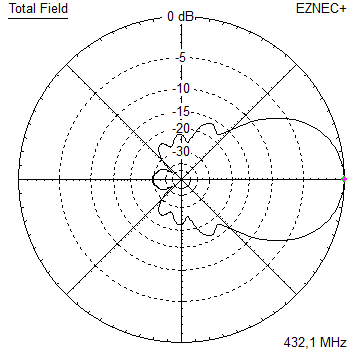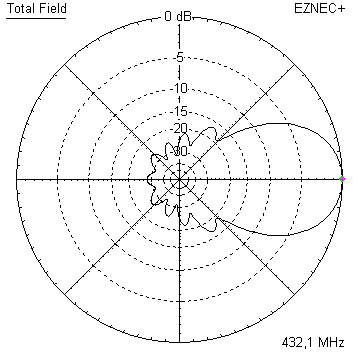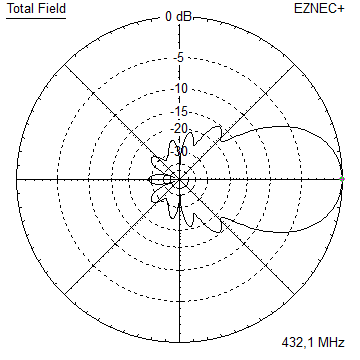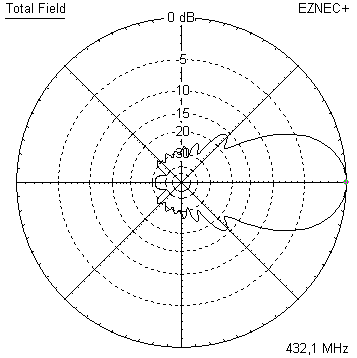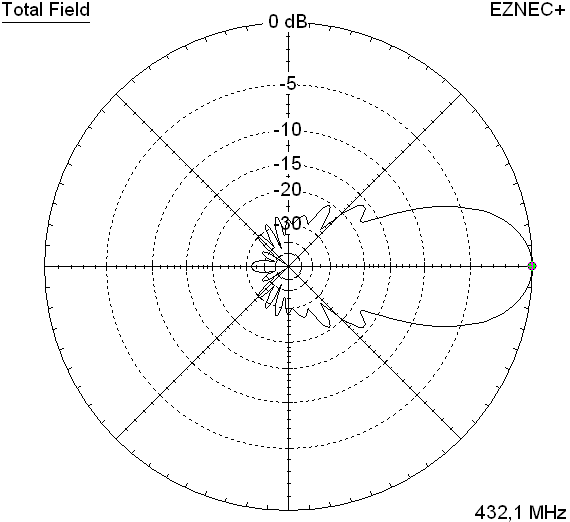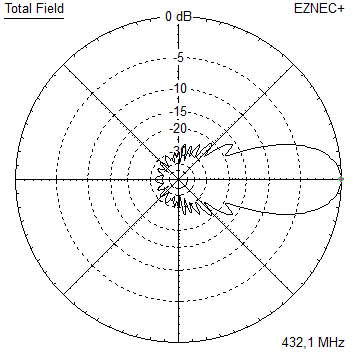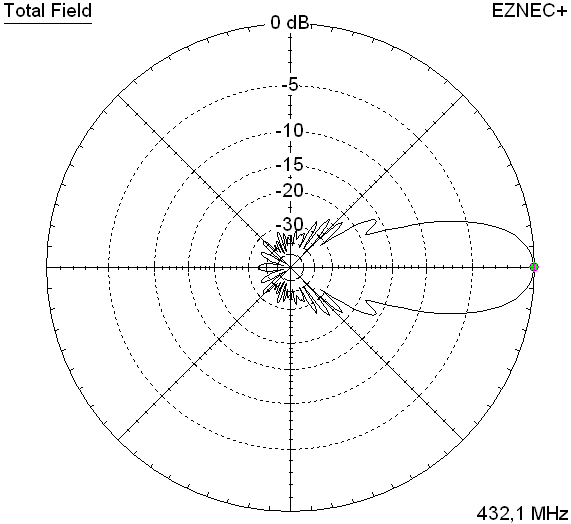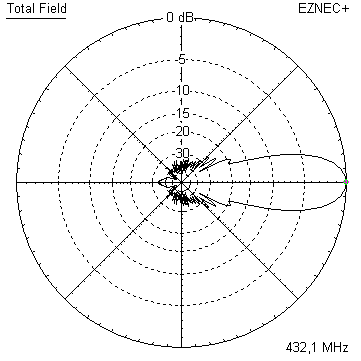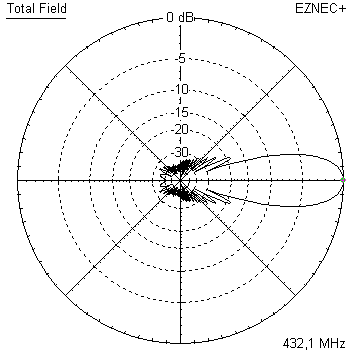
YBN 70-5m 5 Element Yagi with Conventional Driver
This little Yagi has a high F/B, which makes it quite useful as a contest stack.
The YBN 70-5m is the very pilot model which was used to derive all the "On-Boom-BC-Factors"
(see Dubus 1/2011). It has been measured about 40 times using various boom dimensions and
element lengths.
Current Profile
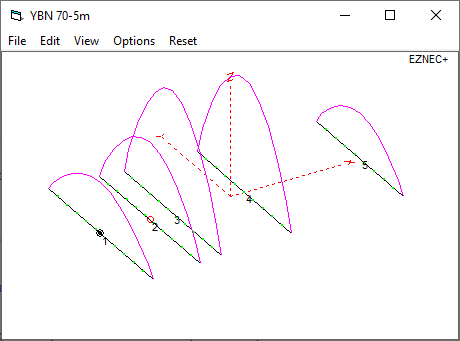
The photo below shows the measurement-Yagi on PP-plastic boom. See the symmetrising 3/4 λ coax line
connected to "gnd" using an n-bushing screwed to the provisional aluminium sub-boom to mount the PP-Yagi to the mast?
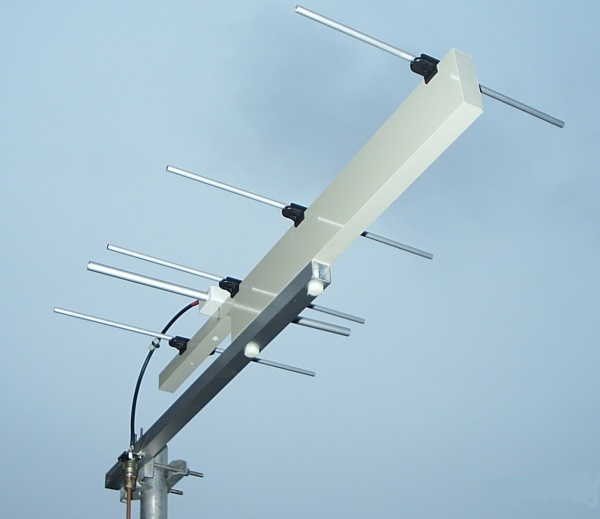
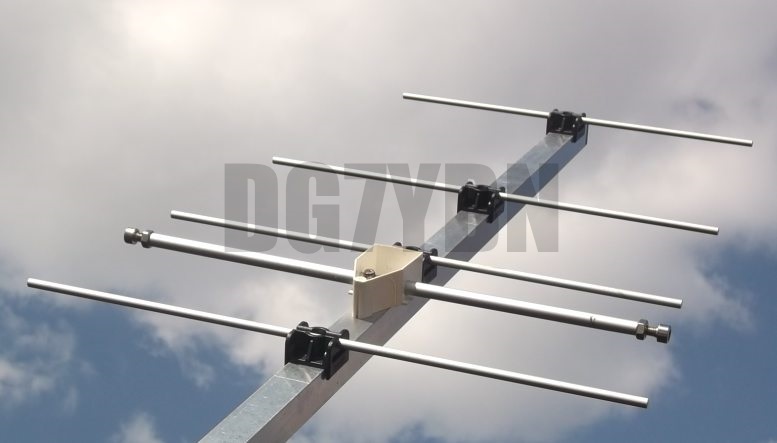
• A lightweight YBN 70-5m built by Kazuo, 7L1TIG - using a sheet metal strip 2 x 10 mm as dipole arms

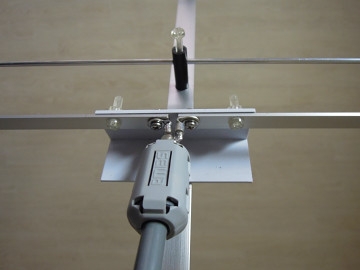
More about the YBN 70-5m with sheet metal dipole incl. VSWR & Return Loss plots on 7L1TIG's website
This website is in Japanese language. Use a free website online translator.
A YBN70-5m for testing BC by Jozef, HA1VQ

Element insulators are HA1KYY made

Performance Data
ele. 6 mm
Gain vs. isotr. Rad. 10.3 dBi
Gain vs. Dipole 8.2 dBD
-3 dB E-plane 53.4 deg.
-3 dB H-plane 69.8 deg.
F/B -24.2 dB
F/R -21.9 dB
Impedance 50/200 ohms
Mechan. Length 480 mm
Electr. Length 0.69 λ
Stacking Dist. h-pol.
top-to-bottom 0.61 m
side-by-side 0.77 m
Geometry
 <= 6 mm ele. semi-insulated
mounting on boom, screw upside down with M3 thread in element (as per DJ3JJ, s. Dubus 1/2010)
<= 6 mm ele. semi-insulated
mounting on boom, screw upside down with M3 thread in element (as per DJ3JJ, s. Dubus 1/2010)
- Plastic Boom & Insulators - - Full Free Space - - Boom 15x15 mm - - Boom 20x20 mm - - Boom 25x25 mm -
Pos. 1/2 Length Segm. 1/2 Length Auto Segm. Full Lgth +4.8 Full Lgth +7.5 Full Lgth +11.5
in NEC in NEC
Refl. 0 168.000 11 168.125 10 340.80 343.75 347.50
DE 91 161.500 11 161.625 11 327.80 330.75 334.50
D1 133 155.750 11 155.875 9 316.30 319.25 323.00
D2 266 151.250 10 151.375 9 307.30 310.25 314.00
D3 480 138.500 9 138.625 8 281.80 284.75 288.50
ele. 6 mm ele. 6 mm ele. 6 mm ele. 6 mm ele. 6 mm
The Drivers diameter is 10 mm for all examples.
"Ready to saw and drill" data for mounting elements on boom with standard insulators on 20 x 20 mm boom including a 30 mm offset from booms end:

The segmentation used for the plastic boom reference Yagi model is auto segmentation at 500 MHz.
Same was used on longer builds (YU7EF EF7015 +27 Yagis) with good results. Note that the delta length
between Auto Segmentation at 432.1 MHz and 500 MHz is covered by adapting element lengths by 0.25 mm only.
The - Plastic Boom & Insulators - element lengths are what I have published in my article on 432 MHz
On-Boom-BC in Dubus 1/2011. Now why are there two segmentations given? Because for measuring the
set of BC numbers and following real builds we have used the plastic standard insulators throughout.
From first measurment on the plastic boom Yagi to real builds. They made a constant offset which is
handled fitting the NEC models with that little higher segmentation base. See the exellent compliance
between simulation and real plot of the PP-boom Yagi below.
Other diameters and building lengths

- Plastic Boom & Insulators - - Full Free Space - - Boom 15x15 mm - - Boom 20x20 mm - - Boom 25x25 mm -
Pos. 1/2 Length Segm. 1/2 Length Auto Segm. Full Length Full Length Full Length
in NEC in NEC
Refl. 0 166.000 11 166.125 10 16x.00 16x.00 16x.00
DE 91 161.500 11 161.625 11 16x.00 16x.00 16x.00
D1 133 153.970 11 154.095 9 16x.00 16x.00 16x.00
D2 266 149.200 10 149.325 9 16x.00 16x.00 16x.00
D3 480 136.100 9 136.225 8 16x.00 16x.00 16x.00
ele. 8 mm ele. 8 mm ele. 8 mm ele. 8 mm ele. 8 mm
- Plastic Boom & Insulators - - Full Free Space - - Boom 15x15 mm - - Boom 20x20 mm - - Boom 25x25 mm -
Pos. 1/2 Length Segm. 1/2 Length Auto Segm. Full Length Full Length Full Length
in NEC in NEC
Refl. 0 164.700 11 164.820 10 16x.00 16x.00 16x.00
DE 91 161.500 11 161.620 11 16x.00 16x.00 16x.00
D1 133 152.600 11 152.720 9 16x.00 16x.00 16x.00
D2 266 147.300 10 147.420 9 16x.00 16x.00 16x.00
D3 480 134.700 9 134.820 8 16x.00 16x.00 16x.00
ele. 10 mm ele. 10 mm ele. 10 mm ele. 10 mm ele. 10 mm
The Drivers diameter is 10 mm for all examples.

• "Ready to saw and drill" data for mounting 4.0 mm elements insulated through boom with SM5BSZ's BC.exe applied
Note that with an elements insulated through boom built for best results boomlength and positions to first /last element must be kept as given.
Because the position of an element relative to its nearer boom end is a serious parameter in the BC.exe.
This table is only valid for:
Boom shape: square
Boom dim: 20 x 20 mm
Wall thickn.: 2.0 mm
Holes in boom: 6.0 mm
Offset rear: 40 mm
Offset front: 40 mm
• Data set for 4 mm elements with rear & front boom end offset = 40 mm

• Data set for 4 mm elements with rear boom end offset = 300 mm for formast mounting

• "Ready to saw and drill" data for mounting 3/16 in (4.76) mm elements insulated through boom with SM5BSZ's BC.exe applied
Note that with an elements insulated through boom built for best results boomlength and positions to first /last element must be kept as given.
Because the position of an element relative to its nearer boom end is a serious parameter in the BC.exe.
This table is only valid for:
Boom shape: square
Boom dim: 20 x 20 mm
Wall thickn.: 2.0 mm
Holes in boom: 7.5 mm
Offset rear: 300 mm
Offset front: 40 mm
• Data set for 3/16 in elements with rear boom end offset = 300 mm for formast mounting

This table is only valid for:
Boom shape: square
Boom dim: 5/8 x 5/8 in
Wall thickn.: 1.6 mm
Holes in boom: 7.5 mm
Offset rear: 300 mm
Offset front: 40 mm
• Data set for 3/16 in elements with rear boom end offset = 300 mm for formast mounting

Pattern and VSWR Plots
Elevation and Azimuth plot at 432.2 MHz
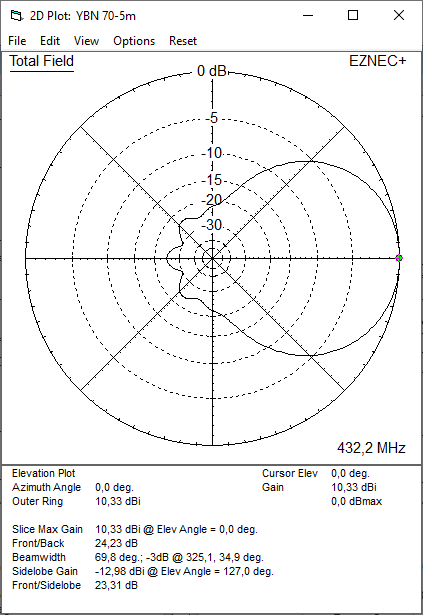

RL and SWR plot with 4nec2

Comparison of simulated and measured Return Loss
Mind that this is on 70 cm Band ... have you seen closer plots of Return Loss by other designers here ever?
There is nothing "trimmed" for best SWR here. The chart shows the PP-boom Yagis without any BC.
This is a measurement "out of the box" with Element lengths trimmed to the 10th of a millimeter
with a large calliper gauge and carefully trimmed and measured symmetrising coax line. This is
yet another confirmation for a low segmentation density close to auto segmetation being much
closer to real world dimensions then often proclamated 30+ segments per wire if it is about a
standard Yagi with a dipole.

Read more about building this Yagi in my Article 'Applied Conversion of Segmented Wires from NEC to 432 MHz Yagi Elements' in Dubus 1/11
Stacking
here is a proposal how to stack for very high F/B using geometrical shift of the Yagis by 1/4 λ in beam direction.
Stacking distance is 700 mm per Yagi - the whole stack is 5.2 m in height then. This stacking scheme helps to boost
the F/B. It goes back on the S53WW-4, a 4 Yagi stack by Roby, S53WW (http://lea.hamradio.si/~s53ww/s53ww-4/s53ww-4.htm)
The Yagis are fed with individual coax lengths from the splitter on. The geometrical shift must be compensated by longer
coax feed lines. A forward bound shift by a 1/4 λ must be encountered by an extra 1/4 λ added to this Yagis feed line
So that it is acutally fed with a phase lag of -90 degrees. Double that for the next Yagis with 2 x 1/4 λ and same scheme
i.e. 3 x 1/4 λ = -270 deg. for the inner pair of Yagis. Mind the real v-factor of your coax and measure lengths exactly please.

Elevation plot with lowest Yagi at 2.6 m over perfect ground
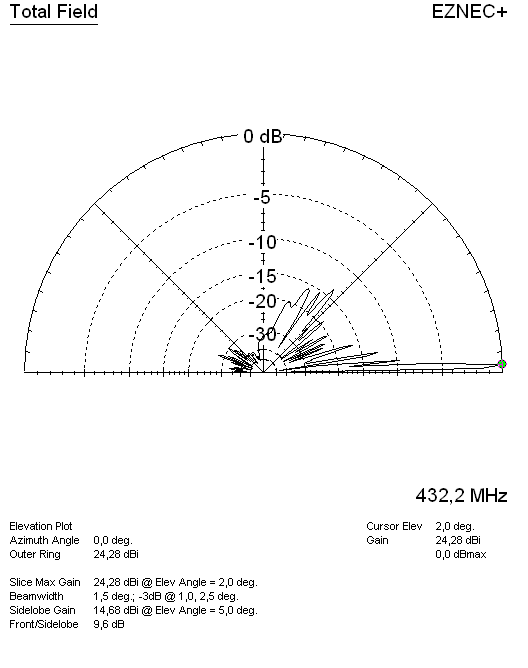
F/B ratio for this configuration is -38 dB at a HBW of 53.2 deg. and gain of 19.58 dBi in free space

Symmetrising 50 to 50 ohms Feedline to 432 MHz Bent DE
The principle is similar to the 1/4 Lambda coax. Adding 2 x 1/4 Lambda or a half wave line does not change anything but allows
to form a gentle bow below the boom or until behind the Reflector. Follow practical construction hints on "Building a Yagi" page.
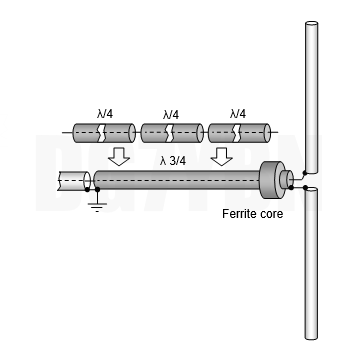
 Attenzione!
Take care when lengthening the coax, measure the right length instead of refering to given v-factors only.
Attenzione!
Take care when lengthening the coax, measure the right length instead of refering to given v-factors only.A good choice may be the diam. 5 mm PTFE coax RG-142 B/U: real resonate length (432.2 Mhz as 3/4 Lambda) shield-shield is around 348 mm
 Find more information on Phasing & Matching Lines page
Find more information on Phasing & Matching Lines page 73, Hartmut, DG7YBN








